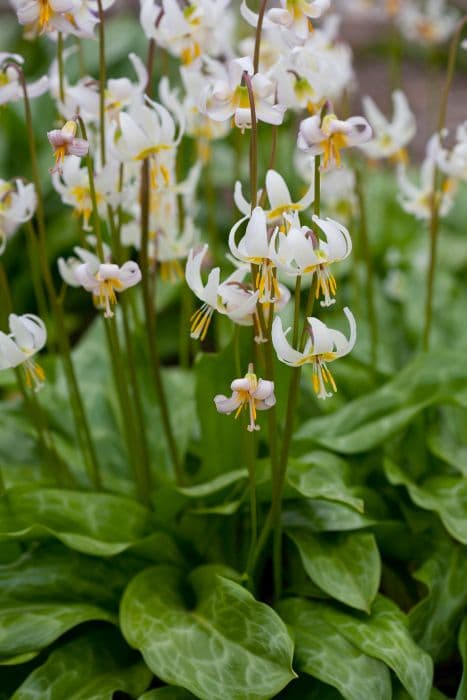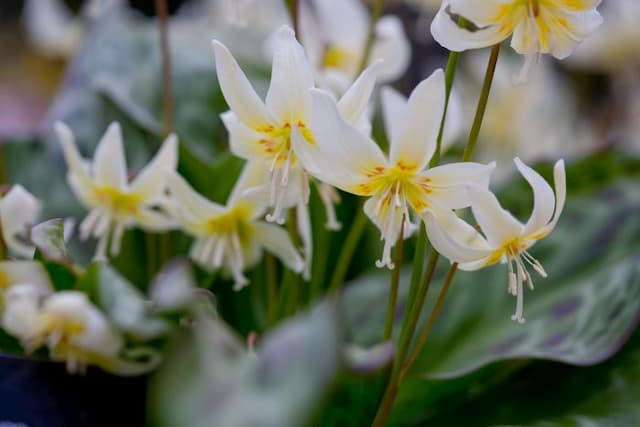Trout Lily Erythronium 'Rosalind'

ABOUT
The Erythronium 'Rosalind', commonly known as the dog's-tooth violet, is a striking perennial plant that is recognized for its distinctive and attractive flowers. The plant features a rosette of long, glossy green leaves that often have brown or maroon mottling, creating a beautiful contrast right at the base. These mottled leaves are lance-shaped, curling gracefully at the edges. As spring progresses, the dog's-tooth violet brings forth its elegant blooms. Each flower is supported on a single, slender stem that arcs gently above the foliage. The flowers themselves are nodding in nature, hanging downwards as if shyly looking towards the ground. Petals are typically a soft, pinkish-lavender color, though they can sometimes appear with a more pronounced pink hue. The petals are also recurved, peeling back from the center to expose the flower's reproductive parts. Not only are the colors appealing, but each petal boasts a delicate texture and a subtle, white base that may give the appearance of being brushed with sunlight. The elongated stamens and pistil extend outward from the center of the bloom, which adds an intricate touch to the charming flowers. When in bloom, this plant adds a splash of color to woodland gardens and shaded areas, merging well with other spring-blooming perennials.
About this plant
 Names
NamesFamily
Liliaceae
Synonyms
Dog's-tooth Violet, Trout Lily
Common names
Erythronium 'Rosalind'
 Toxicity
ToxicityTo humans
Erythronium 'Rosalind', commonly known as dogtooth violet, is not typically considered toxic to humans. However, as with many plants, individuals could potentially have an allergic reaction or sensitivity if they ingest or handle parts of the dogtooth violet without proper knowledge or identification. If ingested in significant quantities, it could cause mild stomach upset. It is always best to avoid eating or touching plants unless you are certain of their safety and have confirmed that they are not harmful.
To pets
Dogtooth violet is not commonly listed as a toxic plant to pets such as dogs and cats. However, individual pets may have different sensitivities or allergic reactions. As with humans, it is advisable not to let your pets ingest parts of the dogtooth violet or any other plants that have not been confirmed to be safe for them, as doing so could potentially result in gastrointestinal upset or other adverse reactions. If any symptoms do appear after ingestion, it is important to consult a veterinarian.
 Characteristics
CharacteristicsLife cycle
Perennials
Foliage type
Deciduous
Color of leaves
Green
Flower color
Pink
Height
1 foot (30 cm)
Spread
1 foot (30 cm)
Plant type
Bulb
Hardiness zones
4
Native area
Europe
Benefits
 General Benefits
General Benefits- Aesthetic Appeal: Erythronium 'Rosalind', commonly known as dogtooth violet, has attractive foliage and charming pink flowers that enhance garden beauty during the spring.
- Pollinator-Friendly: The flowers provide an early source of nectar for pollinators such as bees, therefore supporting biodiversity.
- Low Maintenance: This plant requires minimal care once established, making it a convenient choice for gardeners of all skill levels.
- Naturalizing: Dogtooth violet has the ability to spread and naturalize over time, filling out garden spaces and creating a more robust display each year.
- Shade Tolerance: It thrives in woodland settings with dappled shade, making it suitable for gardens with partial shade.
- Seasonal Interest: The plant adds seasonal interest in spring when few other plants are in bloom, marking the change of seasons with its unique flowers.
 Medical Properties
Medical PropertiesThis plant is not used for medical purposes.
 Air-purifying Qualities
Air-purifying QualitiesThis plant is not specifically known for air purifying qualities.
 Other Uses
Other Uses- Erythronium 'Rosalind', commonly known as the dogtooth violet, can be used in a rock garden setting, where its delicate flowers can complement rugged stone features.
- The plant can serve an educational purpose, illustrating the growth and bloom cycle of spring ephemerals in temperate woodlands.
- Due to its attractive foliage, the dogtooth violet can be used in botanical art, serving as a live model for painting or photography projects.
- The nodding flowers of the dogtooth violet can provide a gentle movement and natural charm to fairy gardens and miniature garden arrangements.
- Dried and pressed, the dogtooth violet's flowers and leaves can be used in craft projects, such as creating bookmarks or decorative note cards.
- The dogtooth violet may be used in a cut flower garden even though it is not traditionally thought of as a cut flower, due to its short vase life, providing a unique and ephemeral floral display.
- In landscape design, its striking shape with mottled foliage can be used as a visual contrast against larger-leaved shade plants.
- For culinary demonstrations, one could utilize the leaves of the dogtooth violet as a natural plating accent, provided they are clean and untreated with any chemicals.
- As a natural dye, the leaves and petals of the dogtooth violet might provide shades of yellow or green, depending on the mordant used.
- The plant can become a subject in macro photography workshops, highlighting the intricate details of the flowers and foliage.
Interesting Facts
 Feng Shui
Feng ShuiThe plant Erythronium 'Rosalind', commonly known as 'Dog's tooth violet', is not used in Feng Shui practice.
 Zodiac Sign Compitability
Zodiac Sign CompitabilityThe plant Erythronium 'Rosalind', commonly known as 'Dog's tooth violet', is not used in astrology practice.
 Plant Symbolism
Plant Symbolism- Renewal and Rebirth: The Erythronium 'Rosalind' blooms in spring, symbolizing the end of winter and the awakening of life, often associated with Easter and the idea of resurrection.
- Purity: Because of its delicate and unblemished flowers, it is often associated with the concept of purity and innocence.
- Hope: Spring flowers like Erythronium 'Rosalind', with their ability to emerge from the cold ground, represent hope and the promise of the future.
- Adaptation: Erythronium 'Rosalind', adapting to different soil conditions, could symbolize the ability to thrive in a variety of life's situations.
- Charm and Attraction: With its striking and unique appearance, this plant often symbolizes an allure or unique beauty.
 Water
WaterDog's tooth violet should be watered thoroughly, ensuring the soil is moist but not waterlogged. During the active growth period in spring, water every week with about 1 gallon per square yard. As they are dormant in summer, reduce watering significantly, and only water lightly if there is an extended dry spell. Ensure good drainage to prevent bulb rot. Over the winter months, watering is typically unnecessary, as the bulb is dormant and excessive moisture can cause decay.
 Light
LightDog's tooth violet thrives in dappled sunlight, mimicking its natural woodland habitat. The ideal spot is under deciduous trees, where it can receive filtered sunlight. Avoid direct, harsh sun, especially during the hot midday hours, as it can scorch the leaves. Morning light with afternoon shade is also suitable for promoting healthy growth.
 Temperature
TemperatureDog's tooth violet prefers cool to moderate temperatures, with ideal conditions ranging between 50°F and 70°F. It can survive temporarily outside of this range, but temperatures below 20°F or above 80°F can be harmful. Ensuring proper mulch can help protect the bulb in colder temperatures.
 Pruning
PruningPruning dog's tooth violet usually isn't necessary. After flowering, allow leaves to die back naturally, as this is when the bulb gathers energy for next year's growth. If you do need to tidy up the plant, remove only dead or yellowing leaves. The best time for this light pruning is in late summer, once the leaves have fully withered away.
 Cleaning
CleaningAs needed
 Soil
SoilThe Dog's Tooth Violet, or Erythronium 'Rosalind', thrives in a soil mix that is rich in organic matter with excellent drainage. A blend consisting of equal parts loam, leaf mold, and gritty material like perlite or fine bark chips are ideal. The soil pH should be slightly acidic to neutral, ranging from 5.5 to 7.0.
 Repotting
RepottingDog's Tooth Violets typically do not require frequent repotting. Repotting should be done every 2-3 years or when they outgrow their container. It's best to repot in the fall after the foliage has died back or in the early spring before new growth starts.
 Humidity & Misting
Humidity & MistingDog's Tooth Violets prefer moderate to high humidity levels, although they are somewhat adaptable. Aim for humidity levels between 40-70% for optimal growth.
 Suitable locations
Suitable locationsIndoor
Ensure bright, indirect light and keep soil moist but not soggy.
Outdoor
Partial shade, moist soil, rich in organic matter.
Hardiness zone
4-9 USDA
 Life cycle
Life cycleThe life of the Erythronium 'Rosalind', commonly known as the dog's tooth violet, begins with a seed germinating in late spring or early summer, often requiring a period of cold stratification. Following germination, a bulb forms underground, which will remain dormant through the warmer months. In the following spring, leaves emerge from the bulb, often mottled in appearance, followed by the distinctive nodding, lily-like flowers that are typically pink or lilac in color. After flowering, typically from April to May, seed capsules develop and eventually release seeds before the plant goes into summer dormancy. The plant's leaves die back, and it relies on nutrients stored in the bulb to survive through the next dormant period. Year after year, the cycle repeats, with the bulb growing larger and occasionally dividing to form clumps, leading to greater floral displays.
 Propogation
PropogationPropogation time
Spring
Erythronium 'Rosalind', commonly known as dog's-tooth violet, is typically propagated through division, a process best done in the autumn months after the plant has died back. The most popular method involves carefully lifting the parent plant from the ground and gently separating the small, tooth-like bulbs, which are actually corms, from the base of the plant. Each corm should be replanted immediately at a depth of about 3 to 4 inches (approximately 7.5 to 10 centimeters) to ensure they do not dry out. Ensure the soil is fertile and well-drained, and the site is partially shaded, mimicking their natural woodland conditions. This method is favored for its simplicity and effectiveness in expanding your collection of Erythronium 'Rosalind'.








